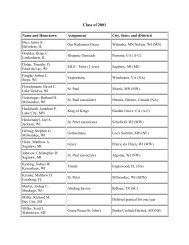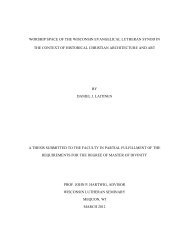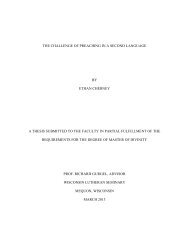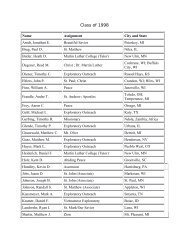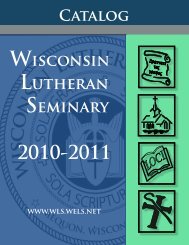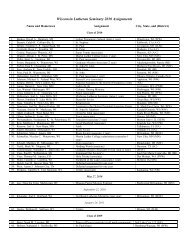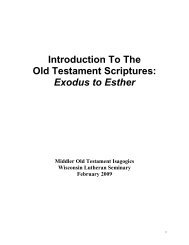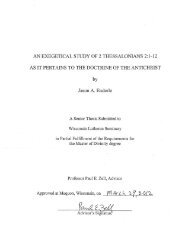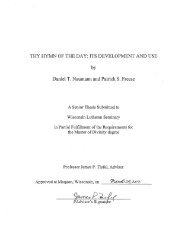Untitled - Wisconsin Lutheran Seminary - WELS
Untitled - Wisconsin Lutheran Seminary - WELS
Untitled - Wisconsin Lutheran Seminary - WELS
Create successful ePaper yourself
Turn your PDF publications into a flip-book with our unique Google optimized e-Paper software.
of Paul’s words. Those who compartmentalize this person into a certain position are not<br />
considering this word in its wider context.<br />
The man of lawlessness<br />
This rebellion would be caused by and associated with “the man of lawlessness” (ὁ<br />
ἄνθρωπος τῆς ἀνομίας) whose coming is the second condition that must take place before<br />
Judgment Day. He “would be revealed” (ἀποκαλυφθῇ). ἀποκαλυφθῇ is the aorist passive<br />
subjunctive from the verb ἀποκαλύπτω, from which the English word “apocalypse” is taken.<br />
The word is used of the revelation of certain persons and circumstances in the end times. As<br />
Paul is speaking of the final coming of Christ, he uses end time language. George Mulligan in<br />
his commentary draws special attention to this word: “The emphatic ἀποκαλυφθῇ by which the<br />
appearance of this sign is described is very significant, not only as marking the ‘superhuman’<br />
character of the coming spoken of, but as placing it in mocking counterpart to the ἀποκάλυψις of<br />
the Lord Jesus Himself.” 36<br />
While Paul does not use the term ἀντίχριστος “antichrist,” the description and<br />
characteristics of this “man of lawlessness” indicate that this man is the Antichrist. The term<br />
ἀντίχριστος is only found in John’s letters (1 Jn 2:18, 22; 4:3; 2 Jn 7) where he speaks of the<br />
Antichrist as well as (lesser) antichrists that have come. John defines this ἀντίχριστος as a liar, a<br />
man who denies that Jesus is the Christ (1 Jn 2:22), one who does not acknowledge that Jesus is<br />
from God (1 Jn 4:3), and a deceiver (2 Jn 7). The fact that Paul does not use the term here does<br />
not mean that he is describing someone else. Here Paul reveals this “man of lawlessness” to be<br />
the Antichrist. He is not using the term as a title but rather as a description of his activities. Paul<br />
is speaking of the one dominant person who stands in opposition to and in place of Christ.<br />
Lenski says in his commentary, “We should not confuse the little antichrists with the great<br />
Antichrist, the antichrists outside of the visible church with the great Antichrist inside of it.” 37<br />
One must not get confused with the use of terminology. The important thing to remember is the<br />
concept of this person described in Scripture, not the title used by the various writers. The term<br />
36 George Milligan, D.D., St. Paul’s Epistles to the Thessalonians: The Greek Text with Introduction and<br />
Notes (Grand Rapids, MI: Wm. B. Eerdmans Publishing Co., 1952), 98.<br />
37 R.C.H. Lenski, The Interpretation of St. Paul’s Epistles to the Colossians, to the Thessalonians, to<br />
Timothy, to Titus and to Philemon (Minneapolis, MN: The Wartburg Press, 1946), 433.<br />
20




